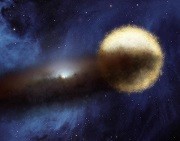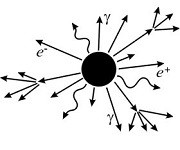 The observational detection of a black hole is extremely challenging because they do not emit any detectable radiation. In 1971, Alistair Cameron investigated the binary epsilon Aurigae, concluding that the companion object of the supergiant residing in the system must be a black hole. His argumentation was based on the peculiarities observed during the eclipses of the main star by this secondary object. Stellar evolution theory precluded the possibility that the companion can be either a proto-star or a star on the Main Sequence. Image credit: NASA/JPL-Caltech
The observational detection of a black hole is extremely challenging because they do not emit any detectable radiation. In 1971, Alistair Cameron investigated the binary epsilon Aurigae, concluding that the companion object of the supergiant residing in the system must be a black hole. His argumentation was based on the peculiarities observed during the eclipses of the main star by this secondary object. Stellar evolution theory precluded the possibility that the companion can be either a proto-star or a star on the Main Sequence. Image credit: NASA/JPL-Caltech
Only a few months after the initial claim, Pierre Demarque & Stephen Morris sent a correspondence to Nature to voice their disagreement with the recent results on epsilon Aurigae. The authors claim that a slightly evolved O-star could be embedded within a disk formed by mass loss from the primary supergiant. While they found the idea of a black hole intriguing, the lack of knowledge about how black holes interact with ordinary matter made them hesitant to ascribe the observational signatures in this system to such an exotic object. Recent observations of the system, however, seem to contradict the presence of a stellar black hole. It remains a puzzling object.
 One of the most striking predictions made about black holes was that they actually radiate through what is now known as Hawking radiation (you can find the original paper in this collection as well). While inconsequential for currently observable black holes (of stellar or galactic origin), this process can lead to rapid mass loss and subsequent evaporation of primordial black holes of very small mass (1015 grams). In 2014, Jeff Steinhauer managed to create a charged black hole analogue by means of an atomic Bose-Einstein condensate. The author showed that self-amplifying Hawking radiation is observed from this analogue black hole, providing a confirmation of the initial prediction. Image credit: NASA
One of the most striking predictions made about black holes was that they actually radiate through what is now known as Hawking radiation (you can find the original paper in this collection as well). While inconsequential for currently observable black holes (of stellar or galactic origin), this process can lead to rapid mass loss and subsequent evaporation of primordial black holes of very small mass (1015 grams). In 2014, Jeff Steinhauer managed to create a charged black hole analogue by means of an atomic Bose-Einstein condensate. The author showed that self-amplifying Hawking radiation is observed from this analogue black hole, providing a confirmation of the initial prediction. Image credit: NASA

A hundred years after the publication of Einstein's seminal work on General Relativity and how mass shapes the space–time continuum around it, gravitational waves — a direct prediction of that theory — were finally detected by the LIGO/VIRGO collaboration. This was a major milestone for physics and an additional robust confirmation of General Relativity. However, the source of the gravitational waves was a surprise itself. It was a binary black hole rather than a binary neutron star that was the first such event to be detected. Krzysztof Belczynski et al. were able to explain this surprising turn of events and showed the reprecussions that this detection has on our understanding of stellar evolution theory and the rarity (or lack thereof) of binary black holes.

